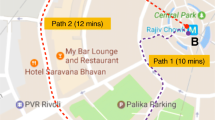Abstract
Historic traffic information is valuable in transportation analysis and planning, e.g., evaluating the reliability of routes for representative source-destination pairs. Also, it can be utilized to provide efficient and effective route-search services. In view of these applications, we propose the k traffic-tolerant paths (TTP) problem on road networks, which takes a source-destination pair and historic traffic information as input, and returns k paths that minimize the aggregate (historic) travel time. Unlike the shortest path problem, the TTP problem has a combinatorial search space that renders the optimal solution expensive to find. First, we propose an exact algorithm with effective pruning rules to reduce the search time. Second, we develop an anytime heuristic algorithm that makes ‘best-effort’ to find a low-cost solution within a given time limit. Extensive experiments on real and synthetic traffic data demonstrate the effectiveness of TTP and the efficiency of our proposed algorithms.














Similar content being viewed by others
References
9th DIMACS implementation challenge - shortest paths. http://www.dis.uniroma1.it/challenge9/
Caltrans Pems. http://pems.dot.ca.gov/
GB Road traffic counts. http://data.gov.uk/dataset/gb-road-traffic-counts/
Google Maps. http://maps.google.com/
Highways agency network journey time and traffic flow data. http://data.gov.uk/dataset/dft-eng-srn-routes-journey-times/
TomTom - at the heart of the journey. http://www.tomtom.com/
Travel time reliability: making it there on time, all the time. http://ops.fhwa.dot.gov/publications/tt_reliability/index.htm (2006)
Abraham I, Delling D, Goldberg AV, Werneck RFF (2012) Hierarchical hub labelings for shortest paths. In: ESA, pp 24–35
Bast H, Funke S, Matijevic D, Sanders P, Schultes D (2007) In transit to constant time shortest-path queries in road networks. In: ALENEX
Cormen TH, Leiserson CE, Rivest RL, Stein C (2009) Introduction to algorithms, 3rd edn. The MIT Press
Demiryurek U, Kashani FB, Shahabi C, Ranganathan A (2011) Online computation of fastest path in time-dependent spatial networks. In: SSTD, pp 92–111
Geisberger R, Sanders P, Schultes D, Delling D (2008) Contraction hierarchies: faster and simpler hierarchical routing in road networks. In: Proceedings of the 7th International conference on experimental algorithms, WEA’08, pp 319–333
Gonzalez H, Han J, Li X, Myslinska M, Sondag JP (2007) Adaptive fastest path computation on a road network: a traffic mining approach. In: VLDB, pp 794–805
González MC, Hidalgo CA, Barabási AL (2008) Understanding individual human mobility patterns. Nature 453(7196):779–782
Gutman R (2004) Reach-based routing: a new approach to shortest path algorithms optimized for road networks. In: ALENEX, pp 100–111
Hua M, Pei J (2010) Probabilistic path queries in road networks: traffic uncertainty aware path selection. In: EDBT, pp 347–358
Kanoulas E, Du Y, Xia T, Zhang D (2006) Finding fastest paths on a road network with speed patterns. In: ICDE, pp 10–10
Kriegel HP, Renz M, Schubert M (2010) Route skyline queries: a multi-preference path planning approach. In: ICDE, pp 261–272
Li PH, Yiu ML, Mouratidis K (2014) Historical traffic-tolerant paths in road networks. In: ACM GIS, to appear
Lomax T, Schrank D, Turner S, Margiotta R (2003) Selecting travel reliability measures. Texas Transp Inst Monograph
Malviya N, Madden S, Bhattacharya A (2011) A continuous query system for dynamic route planning. In: ICDE, pp 792–803
Sanders P, Schultes D (2005) Highway hierarchies hasten exact shortest path queries. In: ESA, pp 568–579
Sankaranarayanan J, Samet H (2010) Query processing using distance oracles for spatial networks. IEEE Trans Knowl Data Eng 22(8):1158–1175
Sankaranarayanan J, Samet H, Alborzi H (2009) Path oracles for spatial networks. PVLDB 2(1):1210–1221
Song C, Qu Z, Blumm N, Barabási AL (2010) Limits of predictability in human mobility. Science 327(5968):1018–1021
Yen JY (1971) Finding the K shortest loopless paths in a network. Manag Sci 17(11):712–716
Zhu AD, Ma H, Xiao X, Luo S, Tang Y, Zhou S (2013) Shortest path and distance queries on road networks: towards bridging theory and practice. In: SIGMOD, pp 857–868
Acknowledgments
Man Lung Yiu was supported by ICRG grant G-YN38 from the Hong Kong Polytechnic University. Kyriakos Mouratidis was supported by research grant 14-C220-SMU-004 from the Singapore Management University Office of Research under the Singapore Ministry of Education Academic Research Funding Tier 1 Grant.
Author information
Authors and Affiliations
Corresponding author
Rights and permissions
About this article
Cite this article
Li, P.H., Yiu, M.L. & Mouratidis, K. Discovering historic traffic-tolerant paths in road networks. Geoinformatica 21, 1–32 (2017). https://doi.org/10.1007/s10707-016-0265-y
Received:
Revised:
Accepted:
Published:
Issue Date:
DOI: https://doi.org/10.1007/s10707-016-0265-y




